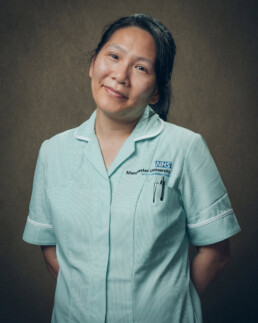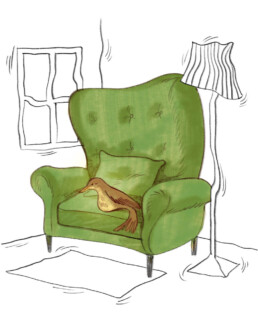
Katie Kirkham
Catering Supervisor
THE BIRTHPLACE OF THE NHS
My name is Katie Kirkham and I’m a domestic assistant at Trafford Hospital. I’ve worked here for around 13 -14 years. When I first started it, I never intended to work here for this long. I’d done a few other jobs but I was between jobs, and one of my friends who works here said to me ‘Oh, they’re looking for domestics at the hospital. I think you’ll fit right in.’ And when I asked her ‘What does a domestic do?’, she goes ‘Oh, it’s a cleaner’. I said, ‘Oh, I don’t want to be a cleaner’. But then I thought ‘I need a job, I’ll give it a go’.
It was supposed to be a stopgap, until I found something else. But when I started, I thought, ‘Wow, this is quite nice actually. I’m enjoying it’. And it’s not just cleaning. There’s more to it than that. You’re interacting with patients. I was quite surprised that I was enjoying it – and then 14 years later, I’m still here.
I’ve done a variety of different jobs. I’ve done shop work, I’ve done restaurant work, I’ve worked in a takeaway, a chemist. Nothing that lasted too long, until I came here! I think it helps that we’ve got good staff. It helps when you’ve got good people in the ward. They’re all nice, friendly people. We all get on with one another. We all look out for one another and we work together as a team. And I think that’s the main thing. If you’ve got good work colleagues, that makes a world of difference.
I worked through Covid. At first it was quite a frightening thing because no one knew anything about Covid. All you heard was what was on the news, and then all of a sudden, out of the blue, our ward became a Covid ward overnight, totally unexpected. The manager came up to myself and another domestic on the ward and said ‘Girls, could you do me a favour. This ward will become a Covid ward tomorrow and the place is going to need a quick clean around, would you be able to do that’. At which point me and Jan were absolutely petrified. But we went and cleaned around, tidied around as best we could.
Altogether there was three wards combined together to make the Covid ward. I think that’s about 70 odd beds in total. It was frightening. My main thought was I’ve got a husband at home who has a low immune system, and I was worried about taking it home to him. But if everyone turned around and said ‘Oh, I don’t want to work on the ward,’ there’d be no one left working on the ward.
So in the end, I just did. I just worked. I went home every night to my husband. When we came onto the ward, we came in our own uniform or our own clothes, then we had to go and change into scrubs. We were all wearing scrubs, doctors, nurses, everyone was in scrubs, so there was a lot of confusion. Quite often people came up to me saying ‘Oh nurse, can you do this’ and I would have to turn around and say ‘Oh, I’m sorry, I’m not a nurse, I’m just a domestic.’ Once a doctor turned round and said ‘Don’t say you’re just a domestic, you’re just as important.’ That meant a lot to me.
Once I had scrubs on and masks on and a doctor came to talk to me about a patient. He thought I was another doctor and I had to turn around and say ‘I’m a domestic!’ and he said ‘We all look alike now, don’t we?’
Once we were on the ward, we had to stay on the ward. To go off the ward, I had to get changed, and then when I came back onto the ward I had to get changed and get scrubbed up again. Rather than do that it was a lot easier just to stay on the ward. Sometimes I’d be on the ward for ten hours a day and not go off. I’d’ just eat my lunch there. On a normal day, I’d go and get my meal somewhere – maybe pop to the shop or go and sit in the restaurant and mingle with other people, but during Covid, once I was on that ward, I stayed on that ward. During Covid, a lot of companies were sending food onto the ward, which I thought was really nice.
We had a ‘wobble room’ – basically it’s just a room where if you get a bit upset or you need someone to talk to, or you just want a bit of time to yourself, you can go and sit in there. I’ve made use of that room many, many times.
I’d never really experienced death in the hospital in all my 13, 14 years of working here, apart from the odd occasion. It was not a regular thing. But during Covid, it obviously became more frequent. It did upset me, because I’ve never seen it on that scale. People would come in, a majority of them elderly people – and you knew that once they’re on that ward, they weren’t leaving, and I did find that distressing. People weren’t allowed onto the ward. They weren’t allowed visitors, so for a lot of the patients that came onto the ward, they came onto the ward and that was it. That was the last time they would see their family. Their last minutes would be alone and frightened in hospital, if we didn’t have people like Monica sitting with them.
During lockdown, I came into work, then when I went home, as soon as I walked through the door, I basically had a tub of gel next to the door as soon as I walked in. I gelled my hands, took all my clothing off and ran straight upstairs and had a bath before I came anywhere near my husband because I didn’t want to bring anything back from the hospital to him. I think I probably did bring it back to him because I caught Covid within the first month of our ward becoming a Covid ward. I caught it along with a load of other staff on the ward.
I think the NHS is very, very important, and I think we’re lucky to have it. So many people in other countries can’t afford healthcare. If you get ill, that’s it really, you have to pay for everything, and some people can’t afford it, they can’t afford medication. So in this country, I think we’re really lucky to have that because there are so many people that need it. If we lost it, that would be a shame.
I’ve seen many changes over the years. The nurse’s home which is now gone. The loss of the children’s ward and A + E. I remember having my son here in 1989 when we used to have a maternity unit which has now gone. I still love it here because the people are friendly, and I’m proud to work here. This hospital was visited by Aneurin Bevan the health minister of the time in 1948 when it was known as Park Hospital. This is where the NHS first started, the birthplace of the NHS.

Illustration: Ann Dinh